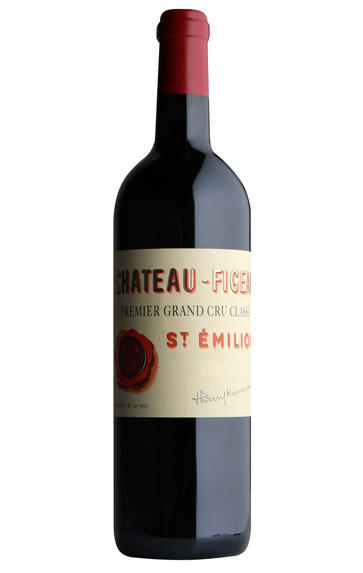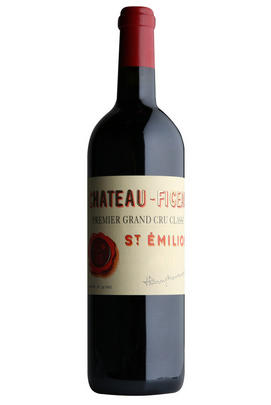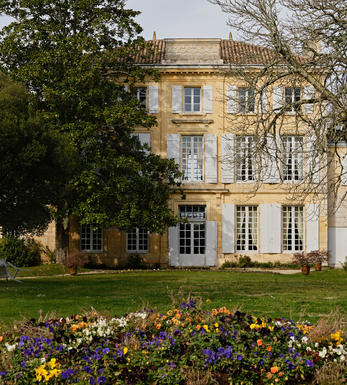
2020 Château Figeac, St Emilion, Bordeaux

Critics reviews
The 2020 Figeac was picked from September 4 to October 1 and underwent vinification free of SO2. Deep purple in color, it is initially backward and sultry on the nose, necessitating 60 minutes before it really opens. It then reveals intense scents of cranberry, raspberry and touches of cassis intermingling with white pepper.
Given that the Cabernets comprise 63% of the blend, this has a typical Left Bank personality but with Right Bank precocity. The palate conveys a sense of vibrancy and vigor on the entry, a dash of black pepper and allspice mingling with the mélange of red and black fruit.The tannins are satin-like in texture, and there’s dark berry fruit and hints of pencil lead and black truffle shavings toward the Pomerol-like finish.
This is a magnificent Figeac from head winemaker Frédéric Faye and his team. This sample really came into its own 2–3 hours after opening.
Drink 2030 - 2065
Neal Martin, Vinous.com (May 2021)
A super-classic wine, the 2020 Figeac sizzles with vertical energy. The château has made a number of tremendous wines in recent vintages, but I don't remember a Figeac with this much saline-drenched intensity and mineral drive. The 2020 is superb, but it won't be ready to drink anytime soon.
The mixture of soil types and varieties, with the high percentage of Cabernet Sauvignon, that is such a signature here, was a huge help in maintaining balance and energy in the wine. Technical Director Frédéric Faye certainly seems to have gotten the most out of the vintage.
Drink from 2035 - 2060
Antonio Galloni, Vinous.com (June 2021)
This delivers concentration and intensity, a ton of black fruits, definitely Cabernet dominant in terms of fruit, and its slightly serious character, with a whoosh of juice on the finish. An extremely elegant and controlled wine, with savoury bilberry and loganberry, then peony and tobacco leaf as it opens.
Tannins are finely layered but there are a lot of them. Not an exuberant Figeac, but this is rarely a wine that rushes out to seduce, it takes its time and has ageing potential in spades. The gravel soils in the drought of the summer meant the grapes slowed their ripening process, although only the youngest vines suffered blockages, and that combined with the high Cabernet content of Figeac means lower alcohols than the past few years, giving a classic balance and a feeling of effortless success.
75% of the production went into the first wine. Harvest September 4 to October 1, a full five weeks. Their final yield here was around 37hl/ha, (higher than in 2019 at Figeac, which was 34hl/ha). As with on the Left Bank, the Cabernet Sauvignons were the lowest yield (30hl/ha), with tiny berries so had to be careful with the extraction. First vintage in the new cellars.
Drink 2029 - 2046
Jane Anson, JaneAnson.com (April 2021)
The 2020 Figeac is a blend of 37% Merlot, 32% Cabernet Franc and 31% Cabernet Sauvignon, weighing in with an alcohol of 13.9% and a pH of 3.7. Opaque purple-black colored, it bursts from the glass with a beautifully vibrant initial wave of pure, pristine black fruits: fresh black cherries, juicy black plums and ripe blackcurrants.
With swirling, a whole array of floral and spice notes is unleashed: lavender, ground cloves, cumin seed, cardamom and rose oil. The medium-bodied palate is surprisingly graceful for the intensity of aromas, featuring ethereal, perfumed black berry notes, framed by a seamless line of freshness and ripe, grainy tannins, finishing on a lingering fragrant earth note.
Far more cerebral and quietly introspective than it is hedonic, this could only be Figeac.
Drink 2027 - 2057
Lisa Perrotti-Brown MW, Wine Advocate (May 2021)
37% Merlot, 32% Cabernet Franc, 31% Cabernet Sauvignon. 77% of production. Cask sample.
Gentle, juicy and pure with nothing overdone. Merlot provides the broad-brush sweetness on attack, the Cabernet the fresh, minerally notes on the finish. Fine grain of tannin and aromatic complexity on the nose and palate; the finesse is there.
Drink 2028 - 2045
James Lawther MW, JancisRobinson.com (May 2021)
This is a really sophisticated young wine with tobacco, crushed stone, currants and dark chocolate on the nose, following through to a medium to full body with intense yet linear tannins and a spicy, fresh finish. Some cloves and black pepper. Graphite at the end. Very long. 37% merlot, 32% cabernet franc and 31% cabernet sauvignon.
James Suckling, JamesSuckling.com (April 2021)
I loved the 2020 Château Figeac, and this beauty offers everything you could want from this site, revealing a dense purple/ruby color to go with gorgeous notes of cassis, tobacco, sappy herbs, and spring flowers as well as an almost Pauillac lead pencil note that develops with time in the glass.
A blend of 37% Merlot, 32% Cabernet Franc, and 31% Cabernet Sauvignon, it's full-bodied and has perfect balance, ultra-fine tannins, and a great, great finish. It brings ample power yet has a weightless elegance and riveting precision reminiscent of the 2016. Don't miss it.
Jeb Dunnuck, JebDunnuck.com (May 2021)
Dense, richly blackcurrant-ripe and mineral-saturated, rich, ripe, and fresh to smell; concentrated, vigorous, firmly but finely tannic, a superb balance; a dense, compact, vivid wine, sweet, vital, racy, and mineral, beautifully sustained and carried across a very long palate, and with an aroma and fruit finish that mirrors all that has gone before.
Figeac’s roughly one-third-each blend here is a clear Right Bank bonus in the current climate, so here there is Cabernet Franc floral subtlety, Cabernet Sauvignon tension and complexity, and, of course, that core Merlot flesh. This is the third great wine in a magnificent trio, brimming with class, scope, finesse.
Great, glorious, beautiful Figeac. Should already be lovely within the decade, and then for three more and beyond.
Drink 2030 - 2060
Michael Schuster, The World of Fine Wine (May 2021)
About this WINE

Château Figeac
Château Figeac is one of the leading St. Emilion estates and its wine, with its high Cabernet content, has often been described as the most Médoc-like in St-Emilion. The estate is located in the north-west of the appellation with its vineyards adjoining those of Cheval Blanc. Its 54 hectares of vineyards lie on a deep, Médoc-like gravel topsoil over a flinty, iron-rich subsoil. Figeac was promoted in 2022 to the level of Premier Grand Cru Classé A, the top tier of the St Emilion classification.

St Émilion
St Émilion is one of Bordeaux's largest producing appellations, producing more wine than Listrac, Moulis, St Estèphe, Pauillac, St Julien and Margaux put together. St Emilion has been producing wine for longer than the Médoc but its lack of accessibility to Bordeaux's port and market-restricted exports to mainland Europe meant the region initially did not enjoy the commercial success that funded the great châteaux of the Left Bank.
St Émilion itself is the prettiest of Bordeaux's wine towns, perched on top of the steep limestone slopes upon which many of the region's finest vineyards are situated. However, more than half of the appellation's vineyards lie on the plain between the town and the Dordogne River on sandy, alluvial soils with a sprinkling of gravel.
Further diversity is added by a small, complex gravel bed to the north-east of the region on the border with Pomerol. Atypically for St Émilion, this allows Cabernet Franc and, to a lesser extent, Cabernet Sauvignon to prosper and defines the personality of the great wines such as Ch. Cheval Blanc.
In the early 1990s there was an explosion of experimentation and evolution, leading to the rise of the garagistes, producers of deeply-concentrated wines made in very small quantities and offered at high prices. The appellation is also surrounded by four satellite appellations, Montagne, Lussac, Puisseguin and St. Georges, which enjoy a family similarity but not the complexity of the best wines.
St Émilion was first officially classified in 1954, and is the most meritocratic classification system in Bordeaux, as it is regularly amended. The most recent revision of the classification was in 2012

Cabernet Sauvignon Blend
Cabernet Sauvignon lends itself particularly well in blends with Merlot. This is actually the archetypal Bordeaux blend, though in different proportions in the sub-regions and sometimes topped up with Cabernet Franc, Malbec, and Petit Verdot.
In the Médoc and Graves the percentage of Cabernet Sauvignon in the blend can range from 95% (Mouton-Rothschild) to as low as 40%. It is particularly suited to the dry, warm, free- draining, gravel-rich soils and is responsible for the redolent cassis characteristics as well as the depth of colour, tannic structure and pronounced acidity of Médoc wines. However 100% Cabernet Sauvignon wines can be slightly hollow-tasting in the middle palate and Merlot with its generous, fleshy fruit flavours acts as a perfect foil by filling in this cavity.
In St-Emilion and Pomerol, the blends are Merlot dominated as Cabernet Sauvignon can struggle to ripen there - when it is included, it adds structure and body to the wine. Sassicaia is the most famous Bordeaux blend in Italy and has spawned many imitations, whereby the blend is now firmly established in the New World and particularly in California and Australia.


Buying options
Add to wishlist
Description
Merlot 37%, Cabernet Franc 36%, Cabernet Sauvignon 34%
Frédéric Faye felt that Figeac’s terroir coped well with the summer drought, evident also in the yield: 37 hl/ha (up on last year’s 34 hl/ha). This is also the first vintage in the new cellar. These elements contribute to a wine that is generous but, given that it’s 70% Cabernet (Sauvignon and Franc) there is a subtle linearity, too.
The nose is a coulis of ripe red fruits, the Cabernets adding a liquorice note. The tannins are marvellously svelte; the great terroir draws that tannic line right to the end. Seduction with style – and the exponential tannins – mean this is a keeper.
Drink 2029 - 2050
wine at a glance
Delivery and quality guarantee